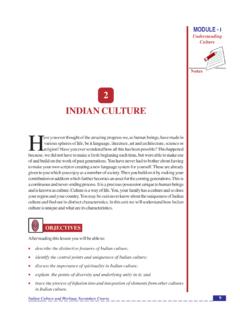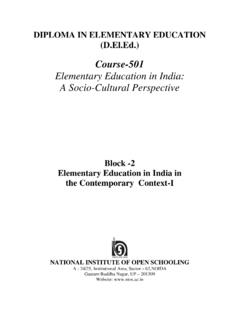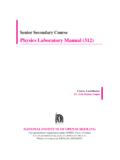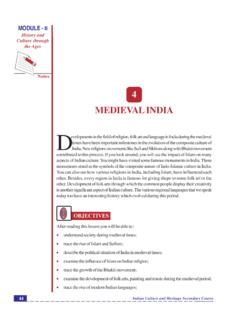Transcription of 9 RELIGION AND PHILOSOPHY IN MEDIEVAL INDIA
1 RELIGION and PHILOSOPHY in MEDIEVAL IndiaNotes 127 Indian Culture and Heritage Secondary CourseMODULE - IVReligion andPhilosophy9 RELIGION AND PHILOSOPHY INMEDIEVAL INDIAN early every month a programme is going on in any auditorium in the city wheresongs of the Sufi saints and Bhakti saints are sung. The popularity of theseprogramems can be seen from the attendance that is there. They are patronizedby the government, by big business houses and even by individuals. The songs and theteachings of the Sufi and the Bhaki saints are relevant even today. Do you know themedieval period in INDIA saw the rise and growth of the Sufi movement and the Bhaktimovement. The two movements brought a new form of religious expression amongstMuslims and Hindus.
2 The Sufis were mystics who called for liberalism in Islam. Theyemphasised on an egalitarian society based on universal love. The Bhakti saints transformedHinduism by introducing devotion or bhakti as the means to attain God. For them castehad no meaning and all human being s were equal. The Sufi and Bhakti saints played animportant role in bringing the Muslims and Hindus together. By using the local language ofthe people, they made RELIGION accessible and meaningful to the common people. OBJECTIVESA fter reading this lesson you will be able to: understand the reasons for the rise of Sufism and Bhakti movements in MedievalIndia; trace the growth of the Sufi movement; identify the major silsilahs of the Sufis; explain the main tenets of Sufism; explain the PHILOSOPHY of the Bhakti saints, Sant Kabir and Guru Nanak; RELIGION and PHILOSOPHY in MEDIEVAL IndiaNotesIndian Culture and Heritage Secondary Course 128 MODULE - IVReligion andPhilosophy rise of Sikhism; explain the ideology of the Vaishnavite saints; recognise the contribution of Sufi and Bhakti saints towards the growth of acomposite Indian culture.
3 THE SUFI MOVEMENTB ackground-Rise of IslamYou will recall that Islam was founded by Prophet Muhammad. Islam saw the rise of manyreligious and spiritual movements within it. These movements were centered mainly aroundthe interpretation of the Quran. There were two major sects that arose within Islam - theSunnis and Shias. Our country has both the sects, but in many other countries like Iran,Iraq, Pakistan etc. you will find followers of only one of the Sunnis, there are four principal schools of Islamic Law, These are based uponthe Quran and Hadis (traditions of the Prophet s saying and doings). Of these the Hanafischool of the eighth century was adopted by the eastern Turks, who later came to greatest challenge to orthodox Sunnism came from the rationalist PHILOSOPHY orMutazilas, who professed strict monotheism.
4 According to them, God is just and hasnothing to do with man s evil actions. Men are endowed with free will and are responsiblefor their own actions. The Mutazilas were opposed by the Ashari School. Founded byAbul Hasan Ashari (873-935 AD), the Ashari school evolved its own rationalist argumentin defence of the orthodox doctrine (kalam). This school believes that God knows, seesand speaks. The Quran is eternal and uncreated. The greatest exponent of this school wasAbu Hamid al-Ghazali (1058-1111 AD), who is credited with having reconciled orthodoxywith mysticism. He was a great theologian who in 1095 began to lead a life of a Sufi. He isdeeply respected by both orthodox elements and Sufis.
5 Al-Ghazali attacked all non-orthodoxSunni schools. He said that positive knowledge cannot be gained by reason but by owed their allegiance to the Quran as much as the Ulemas influence of the ideas of Ghazali was greater because of the new educational systemset up by the state, It provided for setting up of seminaries of higher learning (calledmadrasas) where scholars were familiarised with Ashari ideas. They were taught how torun the government in accordance with orthodox Sunni ideas. These scholars were knownas ulema. Ulema played an important role in the politics of MEDIEVAL SufisContrary to the ulema were the Sufis. The Sufis were mystics. They were pious men whowere shocked at the degeneration in political and religious life.
6 They opposed the vulgarReligion and PHILOSOPHY in MEDIEVAL IndiaNotes 129 Indian Culture and Heritage Secondary CourseMODULE - IVReligion andPhilosophydisplay of wealth in public life and the readiness of the ulema to serve ungodly began to lead a retired ascetic life, having nothing to do with the state. The Sufiphilosophy also differed from the ulema. The Sufis laid emphasis upon free thought andliberal ideas. They were against formal worship, rigidity and fanaticism in RELIGION . TheSufis turned to meditation in order to achieve religious satisfaction. Like the Bhakti saints,the Sufis too interpreted RELIGION as love of god and service of humanity. In course oftime, the Sufis were divided into different silsilahs (orders) with each silsilah having itsown pir (guide) called Khwaja or Sheikh.
7 The pir and his disciples lived in a khanqah(hospice). A pir nominated a successor or wali from his disciples to carry on his Sufis organised samas (a recital of holy songs) to arouse mystical ecstasy. Basra inIraq became the centre of Sufi activities. It must be noted that the Sufi saints were notsetting up a new RELIGION , but were preparing a more liberal movement within the frameworkof Islam. They owed their allegiance to the Quran as much as the ulema in IndiaThe advent of Sufism in INDIA is said to be in the eleventh and twelfth centuries. One of theearly Sufis of eminence, who settled in INDIA , was Al-Hujwari who died in 1089, popularlyknown as Data Ganj Baksh (Distributor of Unlimited Treasure).
8 In the beginning, themain centres of the Sufis were Multan and Punjab. By the thirteenth and fourteenth centuries,the Sufis had spread to Kashmir, Bihar, Bengal and the Deccan. It may be mentioned thatSufism had already taken on a definite form before coming to INDIA . Its fundamental andmoral principles, teachings and orders, system of fasting, prayers and practice of living inkhanqahs had already been fixed. The Sufis came to INDIA via Afghanistan on their ownfree will. Their emphasis upon a pure life, devotional love and service to humanity madethem popular and earned them a place of honour in Indian Fazl while writing in the Ain-i-Akbari speaks of fourteen silsilahs of the , in this lesson we shall outline only some of the important ones.
9 These silsilahswere divided into two types: Ba-shara and Be-shara. Ba-shara were those orders thatfollowed the Islamic Law (Sharia) and its directives such as namaz and roza. Chief amongstthese were the Chishti, Suhrawardi, Firdawsi, Qadiri and Naqshbandi silsilahs. The be-shara silsilahs were not bound by the Sharia. The Qalandars belonged to this Chishti SilsilahThe Chishti order was founded in a village called Khwaja Chishti (near Herat). In INDIA ,the Chishti silsilah was founded by Khwaja Muinuddin Chishti (born c. 1142) who cameto INDIA around 1192. He made Ajmer the main centre for his teaching. He believed thatserving mankind was the best form of devotion and therefore he worked amongst thedowntrodden.
10 He died in Ajmer in 1236. During Mughal times, Ajmer became a leadingpilgrim centre because the emperors regularly visited the Sheikh s tomb. The extent of hispopularity can be seen by the fact that even today, millions of Muslims and Hindus visit hisReligion and PHILOSOPHY in MEDIEVAL IndiaNotesIndian Culture and Heritage Secondary Course 130 MODULE - IVReligion andPhilosophydargah for fufilment of their wishes. Among his disciples were Sheikh Hamiduddin ofNagaur and Qutubuddin Bakhtiyar Kaki. The former lived the life of a poor peasant,cultivated land and refused Iltutmish s offer of a grant of villages. The khanqah ofQutubuddin Bakhtiyar Kaki was also visited by people from all walks of life.
















